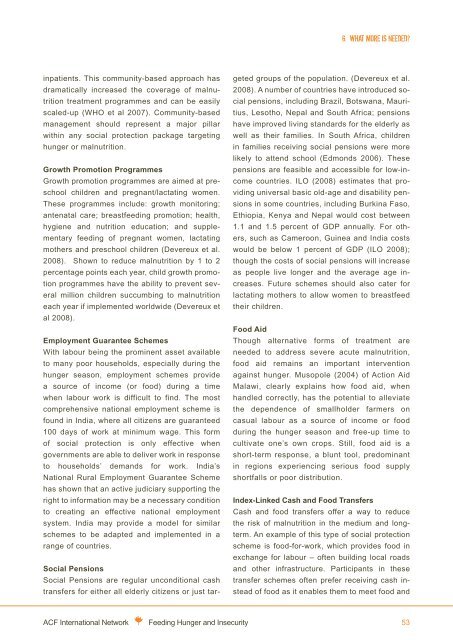Feeding hunger and insecurity
Feeding hunger and insecurity
Feeding hunger and insecurity
- No tags were found...
You also want an ePaper? Increase the reach of your titles
YUMPU automatically turns print PDFs into web optimized ePapers that Google loves.
6. what more is needed?inpatients. This community-based approach hasdramatically increased the coverage of malnutritiontreatment programmes <strong>and</strong> can be easilyscaled-up (WHO et al 2007). Community-basedmanagement should represent a major pillarwithin any social protection package targeting<strong>hunger</strong> or malnutrition.Growth Promotion ProgrammesGrowth promotion programmes are aimed at preschoolchildren <strong>and</strong> pregnant/lactating women.These programmes include: growth monitoring;antenatal care; breastfeeding promotion; health,hygiene <strong>and</strong> nutrition education; <strong>and</strong> supplementaryfeeding of pregnant women, lactatingmothers <strong>and</strong> preschool children (Devereux et al.2008). Shown to reduce malnutrition by 1 to 2percentage points each year, child growth promotionprogrammes have the ability to prevent severalmillion children succumbing to malnutritioneach year if implemented worldwide (Devereux etal 2008).Employment Guarantee SchemesWith labour being the prominent asset availableto many poor households, especially during the<strong>hunger</strong> season, employment schemes providea source of income (or food) during a timewhen labour work is difficult to find. The mostcomprehensive national employment scheme isfound in India, where all citizens are guaranteed100 days of work at minimum wage. This formof social protection is only effective whengovernments are able to deliver work in responseto households’ dem<strong>and</strong>s for work. India’sNational Rural Employment Guarantee Schemehas shown that an active judiciary supporting theright to information may be a necessary conditionto creating an effective national employmentsystem. India may provide a model for similarschemes to be adapted <strong>and</strong> implemented in arange of countries.Social PensionsSocial Pensions are regular unconditional cashtransfers for either all elderly citizens or just targetedgroups of the population. (Devereux et al.2008). A number of countries have introduced socialpensions, including Brazil, Botswana, Mauritius,Lesotho, Nepal <strong>and</strong> South Africa; pensionshave improved living st<strong>and</strong>ards for the elderly aswell as their families. In South Africa, childrenin families receiving social pensions were morelikely to attend school (Edmonds 2006). Thesepensions are feasible <strong>and</strong> accessible for low-incomecountries. ILO (2008) estimates that providinguniversal basic old-age <strong>and</strong> disability pensionsin some countries, including Burkina Faso,Ethiopia, Kenya <strong>and</strong> Nepal would cost between1.1 <strong>and</strong> 1.5 percent of GDP annually. For others,such as Cameroon, Guinea <strong>and</strong> India costswould be below 1 percent of GDP (ILO 2008);though the costs of social pensions will increaseas people live longer <strong>and</strong> the average age increases.Future schemes should also cater forlactating mothers to allow women to breastfeedtheir children.Food AidThough alternative forms of treatment areneeded to address severe acute malnutrition,food aid remains an important interventionagainst <strong>hunger</strong>. Musopole (2004) of Action AidMalawi, clearly explains how food aid, whenh<strong>and</strong>led correctly, has the potential to alleviatethe dependence of smallholder farmers oncasual labour as a source of income or foodduring the <strong>hunger</strong> season <strong>and</strong> free-up time tocultivate one’s own crops. Still, food aid is ashort-term response, a blunt tool, predominantin regions experiencing serious food supplyshortfalls or poor distribution.Index-Linked Cash <strong>and</strong> Food TransfersCash <strong>and</strong> food transfers offer a way to reducethe risk of malnutrition in the medium <strong>and</strong> longterm.An example of this type of social protectionscheme is food-for-work, which provides food inexchange for labour – often building local roads<strong>and</strong> other infrastructure. Participants in thesetransfer schemes often prefer receiving cash insteadof food as it enables them to meet food <strong>and</strong>ACF International Network <strong>Feeding</strong> Hunger <strong>and</strong> Insecurity 53

















